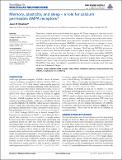Memory, plasticity, and sleep – a role for calcium permeable AMPA receptors?
Author(s)
Shepherd, Jason Dennis
DownloadShepherd-2012-Memory, plasticity, and sleep.pdf (1.486Mb)
PUBLISHER_POLICY
Publisher Policy
Article is made available in accordance with the publisher's policy and may be subject to US copyright law. Please refer to the publisher's site for terms of use.
Terms of use
Metadata
Show full item recordAbstract
Experience shapes and molds the brain throughout life.These changes in neuronal circuits are produced by a myriad of molecular and cellular processes. Simplistically, circuits are modified through changes in neurotransmitter release or through neurotransmitter detection at synapses. The predominant neurotransmitter receptor in excitatory transmission, the AMPA-type glutamate receptor (AMPAR), is exquisitely sensitive to changes in experience and synaptic activity. These ion channels are usually impermeable to calcium, a property conferred by the GluA2 subunit. However, GluA2-lacking AMPARs are permeable to calcium and have recently been shown to play a unique role in synaptic function. In this review, I will describe new findings on the role of calcium permeable AMPARs (CP-AMPARs) in experience-dependent and synaptic plasticity.These studies suggest that CP-AMPARs play a prominent role in maintaining circuits in a labile state where further plasticity can occur, thus promoting metaplasticity. Moreover, the abnormal expression of CP-AMPARs has been implicated in drug addiction and memory disorders and thus may be a novel therapeutic target.
Date issued
2012-04Department
Massachusetts Institute of Technology. Department of Brain and Cognitive SciencesJournal
Frontiers in Molecular Neuroscience
Publisher
Frontiers Research Foundation
Citation
Shepherd, Jason D. “Memory, Plasticity and Sleep - A Role for Calcium Permeable AMPA Receptors?” Frontiers in Molecular Neuroscience 5 (2012).
Version: Final published version
ISSN
1662-5099
1662-5099